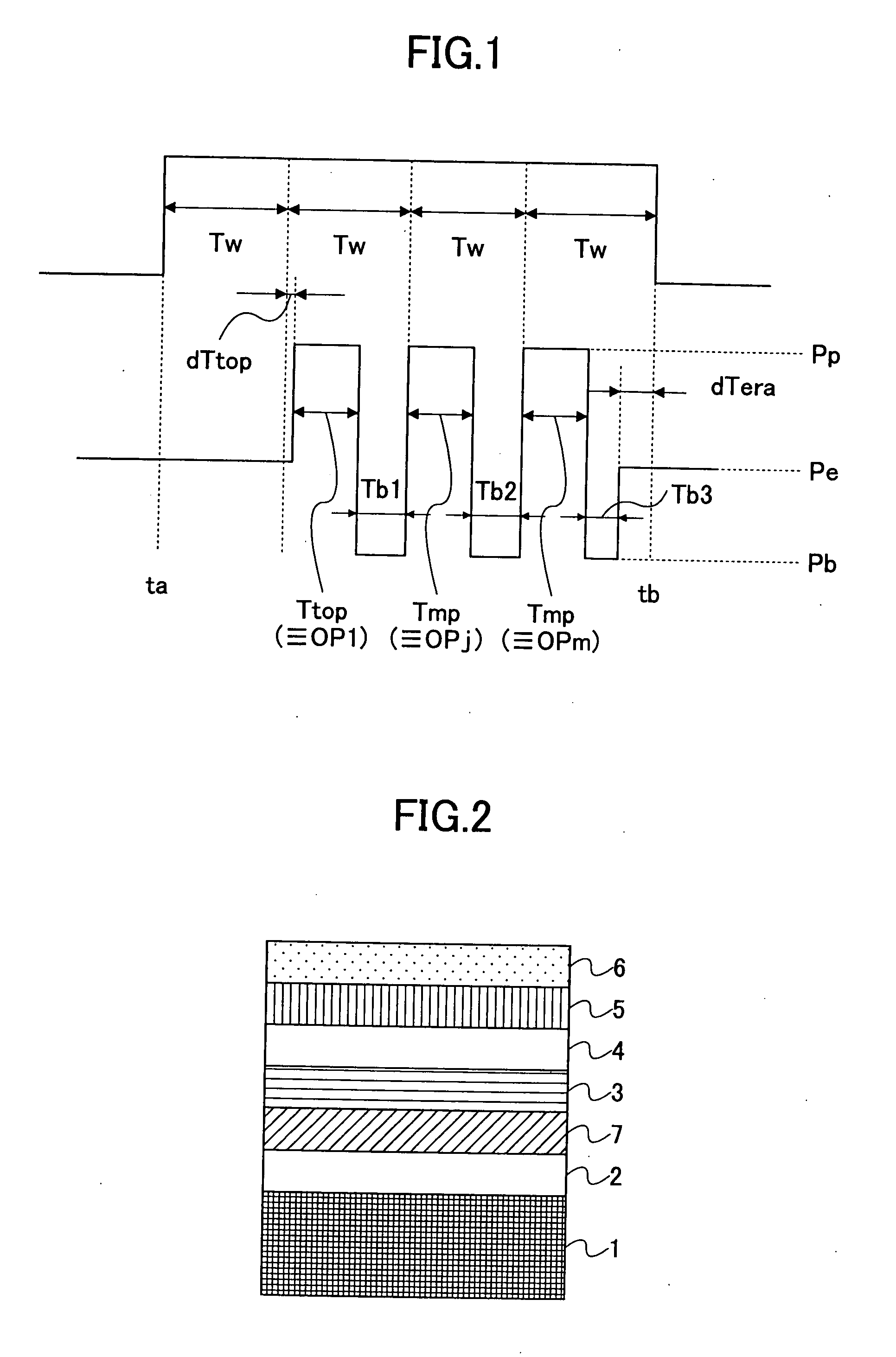Optical recording method
- Summary
- Abstract
- Description
- Claims
- Application Information
AI Technical Summary
Benefits of technology
Problems solved by technology
Method used
Image
Examples
embodiment 1
[0096] First, a phase change optical recording medium was produced as follows:
[0097] By using a substrate made of polycarbonate with a thickness of 0.6 mm, having a groove pitch of 0.74 μm, a groove width of 0.25 μm and a groove depth of 25 nm for recording record marks therein, each layer was laminated thereon by a spattering method.
[0098] First, a target of ZnS:SiO2=80:20 (molar %) was used, and a lower protective layer with a film thickness of 54 nm was provided.
[0099] Then, a target of a composition of Ge:Ag:In:Sb:Te=3.8:0.3:3.5:72:20.4 was used, and a phase change recording layer with a film thickness of 12 nm was provided.
[0100] Then, a target of composite oxide of ZrO2.Y2O3 (3 molar %)·TiO2 (20 molar %) was used, and an interface layer with a film thickness of 3 nm was provided.
[0101] Then, a target of ZnS:SiO2=80:20 (molar %) was used, and an upper protective layer with a film thickness of 11 nm was provided.
[0102] Then, after an SiC layer (sulfating-avoiding layer) wi...
embodiment 2
[0113] By using the optical recording medium same as that in the above-mentioned embodiment 1, recording / playback was performed under the conditions shown in Table 2 below. The other conditions were same as those in the embodiment 1. The maximum linear velocity was 2.40 time speed (8.4 m / s), the minimum linear velocity was 1.0 time speed (3.5 m / s) and the intermediate linear velocity was 1.7 time speed (6 m / s).
TABLE 2recordinglinearrecordingvelocitylinear(timevelocityParameterspeed)(m / s)dTtopTtopTmpdTeraε1.03.5Tw / 6Tw / 6 +Tw / 6 + 6 ns−Tw / 60.476 ns1.76Tw / 600.502.408.4Tw / 6Tw / 60.53
[0114]FIG. 5 shows a result of evaluation of jitter and asymmetry in the recording characteristics thus obtained with the peak power of 15 mW. As shown, satisfactory characteristics were obtained approximately without depending on the linear velocity. In the above-mentioned linear velocity range, the top pulse beginning time (peak power application starting time of the pulse top: dTtop) was determined by a fix...
embodiments 3 through 5
[0115] In an embodiment 4 of the present invention, by using the same optical recording medium as that in the above-mentioned embodiment 1, when the linear velocity was changed from 3.5 m / s through maximum 14 m / s at a rate of 0.5 m / s; the linear velocity at which the reflectance started dropping was around 10.5 m / s (see the embodiment 4 in Table 3 below).
[0116] Then, optical recording media were produced in the same way as that in the embodiment 1 except that the material of the recording layer was changed to compositions of Ag:In:Sb:Te:Ge=0.5:5:68:24.5:2 (embodiment 3 of the present invention) and Ag:In:Sb:Te:Ge=0.3:4:73:19.7:3 (embodiment 5 of the present invention), respectively. Then, when measurement was performed as in the embodiment 4 described above, the reflectance started dropping around 8.5 m / s and 11.5 m / s for the embodiments 3 and 5, respectively, as shown in Table 3.
TABLE 3reflectancedroppingDOW 1 jitter (%)start linear2.4 timevelocity4 time speedspeedembodiment 3 8...
PUM
 Login to View More
Login to View More Abstract
Description
Claims
Application Information
 Login to View More
Login to View More - R&D
- Intellectual Property
- Life Sciences
- Materials
- Tech Scout
- Unparalleled Data Quality
- Higher Quality Content
- 60% Fewer Hallucinations
Browse by: Latest US Patents, China's latest patents, Technical Efficacy Thesaurus, Application Domain, Technology Topic, Popular Technical Reports.
© 2025 PatSnap. All rights reserved.Legal|Privacy policy|Modern Slavery Act Transparency Statement|Sitemap|About US| Contact US: help@patsnap.com



